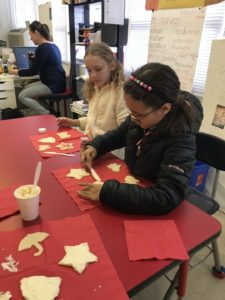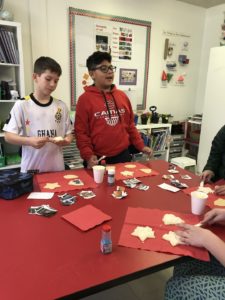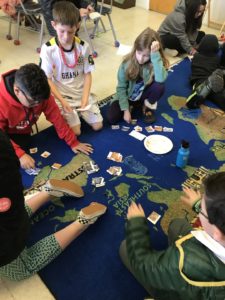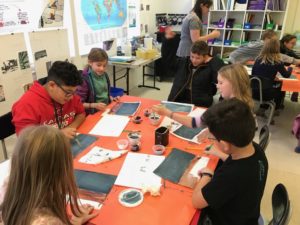History & Geography
Our weekly objectives were to:
- Understand China´s isolation and why the Chinese finally tried to break that isolation.
- Identify the reasons for the development of the Silk Road.
- Relate the idea of the Han dynasty as a golden time to cultural advances such as the invention of paper.
- Describe the social and personal pressures facing young women in ancient China.
- Identify details that reveal Changan to have been a bustling, diverse, exotic capital.
- Recognize Wu Zhaoś extraordinary rise to political power form humble beginnings.
Newsletter by Pierce:
On Monday in English we had our African celebration!
On Tuesday in Science we had to redo our test!
On Wednesday it was wackey!
On Thursday we brought our science information.
On Friday it is BINGO DAY!
Mathematics w/Laura
- Adding and Subtracting Decimals
- Real World Problems: Decimals
- Review and Put on Your Thinking Caps
- Chapter 8 assessment on Tuesday, February 5th
La lectura
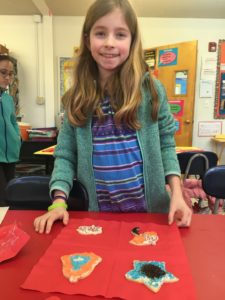 This week we read a very fun folktale: La Sal. This Russian tale is about three sons. The third son, Ivan, is called a fool but is a good, wise, and clever man. When faced with problems, Ivan does not resort to treachery or wickedness as his brothers do. By strumming sweet melodies on his mandolin, he charms a gloomy giant, woos a princess, and wins back the riches stolen from him by his two jealous brothers.
This week we read a very fun folktale: La Sal. This Russian tale is about three sons. The third son, Ivan, is called a fool but is a good, wise, and clever man. When faced with problems, Ivan does not resort to treachery or wickedness as his brothers do. By strumming sweet melodies on his mandolin, he charms a gloomy giant, woos a princess, and wins back the riches stolen from him by his two jealous brothers.
Our weekly objectives were to:
- identify the authorś point of view
- identify the common folktale moral (in this case: goodness wins over evil)
- work together to turn the story into a short skit, creating dialogue. (We will really dig into this next week.)
- identify digraphs, which are two letters that make one sound (our spelling list this week was full of digraphs- ll, rr, ch)
- review use of semicolons, colons, and other marks. (Colons are used to present a list of things, before quotation marks, and after the greeting in a letter. Semicolons are used to separate the components of a long series that contains commas. Parentheses are used around words that add information to, or clarify, a sentences. Hyphens separate some compound words.)
On Monday we celebrated a combined reading for December and January with a cookie decorating party after lunch. Yumm!!
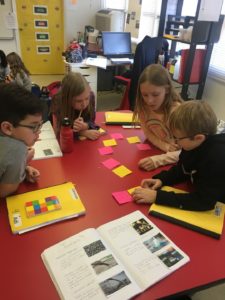
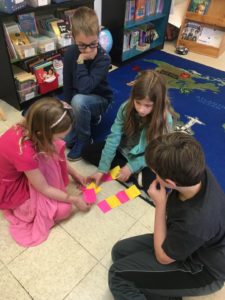 Ciencias
Ciencias
Students were given the opportunity to retake their science test (since I was absent on the day it was given). I was supposed to hand them back (but neglected to do so). They will receive them on Monday.
We began our new science topic: Natural Resources. We reviewed what we have learned about soils, rocks, and landforms. Students worked in groups to create a concept map to bring these ideas together. We focused on earth materials as renewable and nonrenewable natural resources by viewing and discussing a video.
We also read, as a whole class, about monuments around the world. It was interesting to compare and contrast theses 4 monuments in a graphic organizer. The Washington Memorial, The Vietnam Veterans Memorial, The Taj Mahal, The Great Pyramid. What were they made out of? Who were they made for? How long did construction take?
Our focus question this week was: What are natural resources and what is important to know about them?
Specialists:
Music with Ms. Erin
In January we learned about musical form; verse, chorus (refrain), introduction, and coda. We learned about theme and variations by studying the music of W. A. Mozart, J. S. Bach, and Liszt’s variations on a theme by Paganini.
In February we will be working on reading notation in the treble and bass clefs, and introducing the skill of sight singing. We will identify, write, read, sing, and play music from written notation using a variety of musical styles. We will learn about jazz and the Harlem Renaissance, while being introduced to jazz “lead sheets”.
Art with Ms. Kelly
We worked on 2 projects in January:
Art Project: Cakes in the style of Wayne Thiebaud
Book and Website: Artwork by Wayne Thiebaud
Goals:
- Learn about the artist, Wayne Thiebaud (who is still painting at age 98!)
- Observe light and dark shapes, and shadows
- Draw a cylinder with a wedge cut out
- Use oil pastels to create shading and shadows
I’m sure you’ve enjoyed these beautiful cakes on the bulletin board at school!
Art Project: Figures in the style of Jacob Lawrence
Book: Jacob Lawrence
- Learn about Jacob Lawrence, an African American artist
- (who grew up in Harlem but moved to Seattle and taught art at University of Washington)
- Use basic shapes to draw students at the blackboard
- Use tempera paint for the background and figures in your artwork
We are still working on this project, and I plan to display them on a bulletin board in February.

